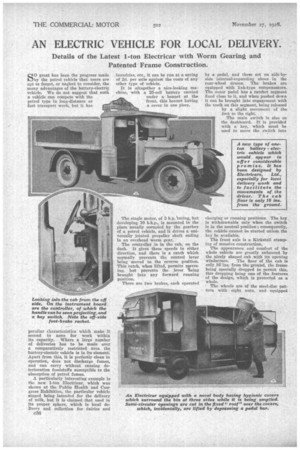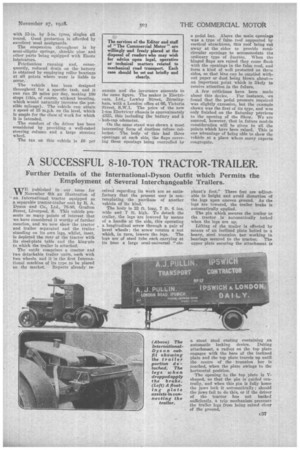AN ELECTRIC VEHICLE FOR LOCAL DELIVERY.
Page 20

Page 21

If you've noticed an error in this article please click here to report it so we can fix it.
Details of the Latest 1-ton Electricar with Worm Gearing and Patented Frame Construction.
Q40 great has been the progress made
by the petrol vehicle that users are apt to forget, or neglect to consider, the many advantages of the battery-electric vehicle. We do not suggest that such a vehicle can compete with the petrol type in long-distance or fast transport work, but it has peculiar characteristics which make it second to none for work within its capacity. Where a large number of deliveries has to be made over a comparatively restricted area the battery-electric vehicle is in its element. Apart from this, it is perfectly clean in operation, does not discharge fumes, and can carry without causing deterioration foodstuffs susceptible to the ' absorption of petrol fumes.
• A particularly interesting example is the new 1-ton Electricar, which was shown at the Public Health and Co*. grcss Exhibition, the particular vehicle staged being intended for the delivery of milk, but it is claimed that used in its proper sphere, which is local delivery and collection for dairies and laundries, etc., it can be run at a saving of 2d. per mile against the costs of any other type of vehicle.
It is altogether a nice-looking machine, with a 25-cell battery carried under a bonnet at the front, this bonnet having a cover in one piece.
The single motor, of 3 h.p.'rating, but developing la b.h.p., is mounted in the place usually occupied by the gearbox of a petrol vehicle, and it drives a universally jointed propeller shaft ending In an overhead worm gear.
The controller is in the cab, on the dash. It gives three speeds in either • direction, and there is a catch which normally prevents the control lever being moved to the reverse position. This catch, when lifted, permits reversing, but prevents the lever being brought into any forward running position.
There are two brakes, each operated by a pedal, and these act on side-byside internal-expanding shoes in the rear-Wheel drums. The brakes are equipped with link-type compensators. The outer pedal has a ratchet segment fixed close to it, and 'when pushed down it can be brought into engagement with the teeth on this segment, being released by a slight movement of the foot to the right.
The main switch is • also on the dashboard. It is provided with a key, which must be used to move the switch into
charging or running positions. The key is withdrawable only when the switch is in the neutral position ; consequently, the vehicle cannot be started unless the key be available.
The front axle is a Kirkstall stamping of massive construction.
The appearance and comfort of the whole vehicle are greatly enhanced by the nicely shaped cab with its opening
windscreen. The floor of the cab is only 16 'ins, from the ground, the frame being specially dropped to permit this, this dropping being one of the features of the design, which is protected as a whole.
The wheels are of the steel-disc pattern with eight nuts, and equipped
with 33-in. by 5-in. tyres, singles all round. Good protection is afforded by excellent steel mudguards.
The suspension throughout is by semi-elliptic springs, shackle pins and other parts being equipped with Enots lubricators.
Frictionless running and, consequently, reduced drain on the battery is obtained by employing roller bearings at all points where wear is liable to occur..
The vehicle has been designed throughout for a specific task, and it can run 20 miles per day, making 100 stops (this, of course, without boosting, which would naturally increase the possible mileage). The vehicle can attain a speed of 15 m.p.h. on the level, which is ample for the class of work for which it is intended.
The comfort of the driver has been considered by providing a well-raked steering column and a large steering wheel.
The tax on this vehicle is £6 per annum and the insurance amounts to the same figure. The maker is Eleetricars, Ltd., Lawley Street, Birmingham, with a London office at 66, Victoria Street, SAVA. The price of the new 1-ton Flectricar chassis is approximately £325, this including the battery and . hub-cap odometer.
On the same stand was shown a most interesting form of dustless refuse collector. The body " of this had three openings at each side, the flaps covering these openings being controlled by a pedal bar. Above the main openings was a type of false roof supported by vertical stanchions, this roof being cut away at the sides to provide semicircular openings to accommodate the ordinary type of dustbin. When the hinged flaps are raised they come flush with the openings in the false roof, and form a kind of well protected on three sides, so that bins can be emptied without paper or dust being blown about— an important point which is likely to receive attention in the future.
A .few criticisms have been made about this device. For instance, we found that the pedal pressure required was slightly excessive, but the example shown was the first of its type, and was only finished on the Saturday ptevious to the opening of the Show. We are assured, however, that in future models consideration will be given to all the points which have been raised. This is one advantage of being able to show the vehicle at a place where many experts congregate. .


































